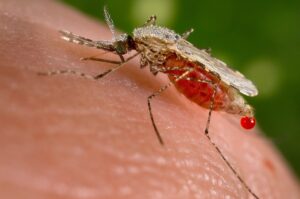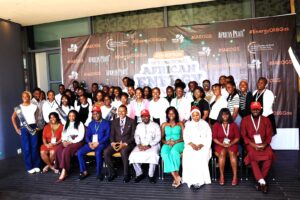Scientists Propose Novel Way of Treating Mosquitoes for Malaria
Two tiny mosquitoes native to Africa rest on someone’s, Mosquitoes should be given malaria drugs to clear their infection so they can no longer spread the disease, say US researchers. Malaria parasites, which kill nearly 600,000 people a year, mostly children, are spread by female mosquitoes when they drink blood. Current efforts aim to kill mosquitoes with insecticide rather than curing them of malaria. But a team at Harvard University has found a pair of drugs which can successfully rid the insects of malaria when absorbed through their legs. Coating bed nets in the drug cocktail is the long-term aim. Sleeping under a bed net has been one of the most successful ways of preventing malaria as the main malaria-spreading mosquitoes hunt at night. Vaccines to protect children living in high-risk malaria areas are also recommended. Nets are both a physical barrier and also contain insecticides which kill mosquitoes that land on them. But mosquitoes have become resistant to insecticide in many countries so the chemicals no longer kill the insects as effectively as they used to. “We haven’t really tried to directly kill parasites in the mosquito before this, because we were just killing the mosquito,” says researcher Dr Alexandra Probst, from Harvard.
Urgent action needed as malaria resists key drug
The researchers analysed malaria’s DNA to find possible weak spots while it is infecting mosquitoes. They took a large library of potential drugs and narrowed it down to a shortlist of 22. These were tested when female mosquitoes were given a blood-meal contaminated with malaria. In their article in Nature, the scientists describe two highly effective drugs that killed 100% of the parasites.
The drugs were tested on material similar to bed nets.
“Even if that mosquito survives contact with the bed net, the parasites within are killed and so it’s still not transmitting malaria,” said Dr Probst. “I think this is a really exciting approach, because it’s a totally new way of targeting mosquitoes themselves.” She says the malaria parasite is less likely to become resistant to the drugs as there are billions of them in each infected person, but less than five in each mosquito. The effect of the drugs lasts for a year on the nets, potentially making it a cheap and long-lasting alternative to insecticide, the researchers say.
This approach has been proven in the laboratory. The next stage is already planned in Ethiopia to see if the anti-malarial bed nets are effective in the real world. It will take at least six years before all the studies are completed to know if this approach will work. But the vision is to have bed nets treated with both anti-malaria drugs and insecticide so that if one approach doesn’t work, then the other will.
The ‘Space Archaeologists’ Hoping to Save our Cosmic History
The infrastructure of humanity’s journey into space may only be decades old, but some of it has already been lost. A new generation of “space archaeologists” are scrambling to save what’s left. Space is being commercialised on a scale unseen before. Faced by powerful commercial and political forces and with scant legal protections, artefacts that tell the story of our species’ journey into space are in danger of being lost – both in orbit and down here on Earth. Like Stonehenge, these are irreplaceable artefacts and sites that have a timeless significance to humanity because they represent an essential stage in the evolution of our species. They are often also expressions of national pride because of the industrial and scientific effort needed to achieve them.
Sometimes they are also memorials to those who died in the course of ambitious space programmes. They also have another use. Studying these artefacts and sites helps researchers better understand how astronauts interact with new technology, adapt to new environments and develop new cultural practices. The conclusions of researchers can influence the design of future spacecraft and help future space missions succeed. Can a new generation of pioneering space archaeologists like Alice Gorman and Justin Walsh help save our space heritage for coming generations, and how might their work change space exploration in the future?
On 15 January 2025, the World Monuments Fund’s Watch List of 25 threatened heritage sites was released, surprising many by including the Moon, with a focus on the Apollo 11 landing site, in addition to the endangered sites on Earth. It is rather ironic then, that same day, Firefly Aerospace’s Blue Ghost lunar lander blasted off from Kennedy Space Center on board a SpaceX rocket to lay “the groundwork for the future of commercial exploration” of the Moon, according to the company. Firefly became the second commercial company to land without difficulty or damage on the Moon when Blue Ghost safely touched down around 30 miles (50 km) away from the site of the Nasa LCROSS impactor, 90 miles (150km) away from the Soviet Luna 24 probe site, and in the neighboring lunar sea, vast plains of solidified lava, to where Neil Armstrong’s footprints can be found.
Nasa The heritage that archaeologists want to protect includes the footprints left on the Moon by the Apollo astronauts in the 1960s and 70s.The heritage that archaeologists want to protect includes the footprints left on the Moon by the Apollo astronauts in the 1960s and 70s (Credit: Nasa) “We don’t know yet how to physically operate on the Moon,” says space archaeologist Justin Walsh, a professor at Chapman University in California. “Any mission that approaches or enters one of those historic sites is going to have consequences that we can’t yet foresee. Whatever precautions we can take, we really must take to keep that damage to a minimum.”
But it isn’t just sites on the Moon that experts are worried about. Elon Musk wants Nasa to deorbit and possibly destroy the historically significant International Space Station sooner than the space agency intends. “The window of time we must get procedures and protocols accepted by the international space community is closing,” says Alice Gorman, a space archaeologist and associate professor at Flinders University in Adelaide, Australia. Three years ago, Nasa astronaut Kayla Barron conducted the first ever archaeological fieldwork outside the Earth (and in zero gravity) while orbiting the planet at about a height of 250 miles (400km). On 14 January 2022, she used bright yellow adhesive tape to mark out the corners of 1 sq m (10.7 sq ft) on a science rack in a module of the ISS – like an archaeological trench – and repeated the process in five other locations, ranging from the galley to the toilet.





